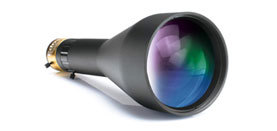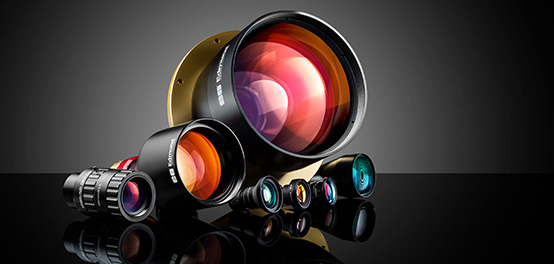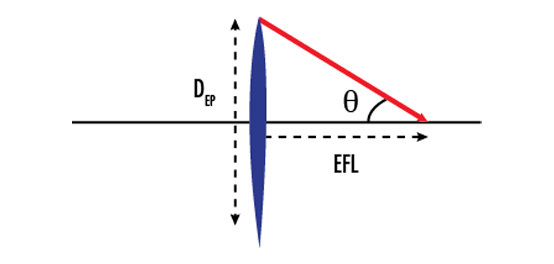In-line Illumination
This is Section 11.2 of the Imaging Resource Guide.

Figure 1: Diagram of in-line illumination within a telecentric lens.
Vastly different results will also come from comparing in-line illumination to backlit illumination. Figure 2 shows a chrome on glass, positive USAF 1951 contrast target illuminated both with bright-field illumination and with in-line illumination.

Figure 2: Chrome on glass USAF 1951 resolution target with backlit illumination (Figure 2a), and in-line illumination (Figure 2b).
The most immediate difference between the two types of illumination is the complete contrast reversal between the two images. Additionally, the defects in the target are more readily apparent in the backlit image, which, depending upon the application, can be either a positive or a negative effect. Interestingly, the highly reflective nature of the target yields about 10% better contrast for the in-line image when compared to the brightfield image – the reason for this is explained below.
When to Use In-Line Illumination
When considering using in-line illumination, it is important to understand exactly where it is applicable and where it is not. In-line illumination is ideal for the inspection of specular or semi-specular objects, such as semiconductor wafers or CCDs, due to the nature of the rays on the illumination path. Using two different telecentric lenses, one with in-line illumination and one with a ring light, images of the same CCD demonstrate the differences between darkfield (using a ring light) and inline illumination. The images are shown in Figure 3.

Figure 3: Comparison of darkfield illumination (left) with brightfield in-line illumination (right).
| Darkfield Illumination | Brightfield In-line Illumination |
|---|---|
| Low Contrast Wires | High Contrast Wires |
| Bright Chip on Faceplate | Dark Chip on Faceplate |
| High Contrast Image in Some Areas but Inconsistent Across the Field | Even Illumination with Consistent Contrast between Features |
Table 1: Comparison of brightfield and in-line illumination.
In-line illumination would be a better choice to inspect the wires along the edge of the CCD due to the higher, more even contrast between the wires and the rest of the CCD. As shown in Figure 4, the reason that the wires in Figure 3 appear more black compared to the background when using in-line illumination is that the background is specular and reflects all the light directly back into the lens, while the diffuse wires scatter only a small amount of light back to the lens. With darkfield illumination, the background is dark since most of the specular reflection does not get back into the lens. The diff use wires’ reflection is also dim, which causes a low contrast between the wires and background.
With darkfield illumination, the rays originating from the ring light are scattered by the object into the lens. The reflections will vary based on the angle of the individual sources in the ring light as well as the angle of the wires themselves with respect to the CCD surface and the solder material at the tips, which is why the reflections have non-uniform pixel values along the length of the wire. Using in-line illumination, all of the rays are reflected by the object and scattered away from the lens such that very little of the light that hits the wires is reflected back into the lens and onto the sensor. The more even contrast of the background, along with the stronger contrast of the wires, makes in-line illumination a better choice for the inspection of the wires than darkfield illumination.
If the CCD cover glass were to be inspected for digs or chips, in-line illumination would also be the more advantageous choice since the overall image has a much more even contrast. The dark chips shown using in-line illumination) would appear at a much higher contrast to the busy CCD background than the chips shown in the high contrast image formed using a darkfield system, as demonstrated in Figure 3.

Figure 4: With the darkfield ring light illumination (left), most, but not all, of the light reflecting off a specular object does not make it back into the lens, while essentially all of the light with in-line illumination (right) reflects off the specular object and goes back into the lens.
When Not to Use In-Line Illumination
Due to its multiple advantages, it is often believed that in-line illumination is always the superior choice for space-constrained systems. Unfortunately, it is not the best solution for all applications. Diffuse or dimly-reflecting objects are more effectively imaged using different illumination techniques. The nature of putting a beamsplitter in the path of the imaging train introduces several sources of stray light into an inline illumination system, and the only options to fully address this would introduce even more severe problems into the optical train. Therefore, there will always be light that gets from the illumination source onto the sensor without having reflected or scattered off the object. This causes a haze over the image, keeping regions of black on the object from being truly black in the image. This loss in contrast is not always problem, but it may be an issue in low-signal applications, such as imaging diffuse or dark objects. An example of this is shown in Figure 5 where a ring light illuminates a wooden object evenly, but the in-line illuminated image is grey with a hot spot in the middle.














 Previous Section
Previous Section 
















or view regional numbers
QUOTE TOOL
enter stock numbers to begin
Copyright 2023, Edmund Optics Inc., 101 East Gloucester Pike, Barrington, NJ 08007-1380 USA
California Consumer Privacy Acts (CCPA): Do Not Sell or Share My Personal Information
California Transparency in Supply Chains Act